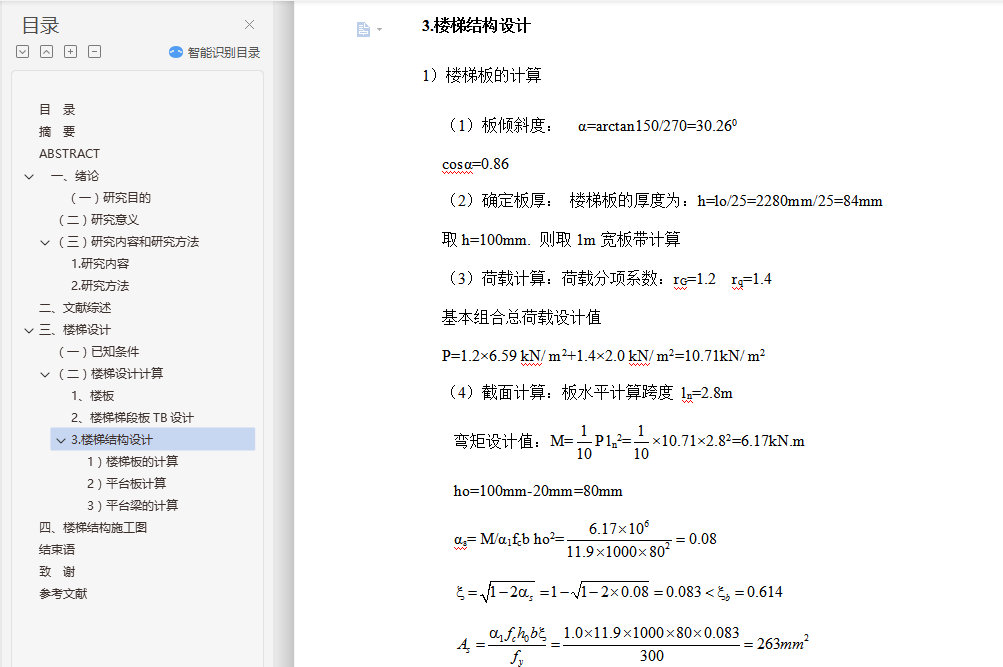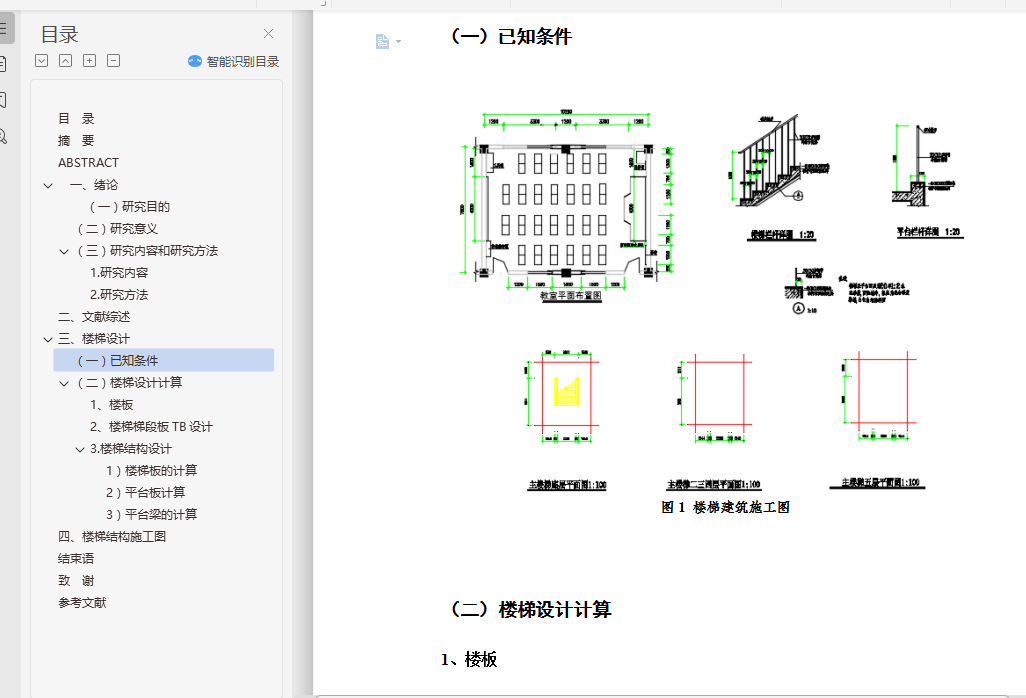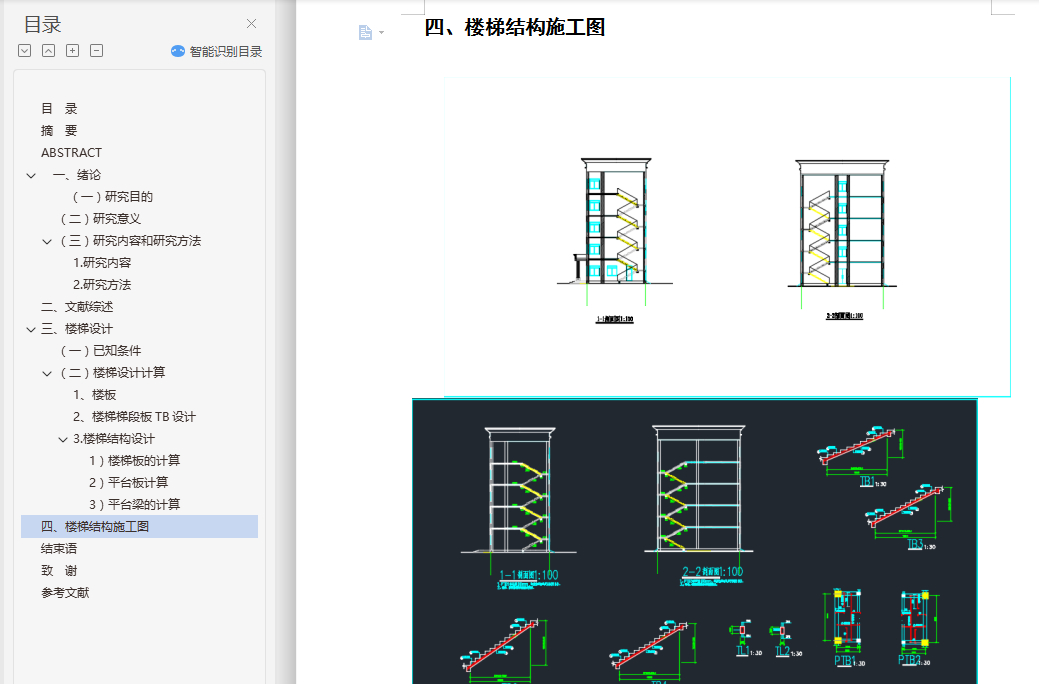引 言
楼梯是建筑物中主要的垂直交通设施之一,楼梯的主要功能是通行和疏散。
楼梯的数量、位置、形式和楼梯的宽度、坡度均应该符合上下通畅、疏散方便的原则,楼梯间必须直接采光,采光面积应小于1/12楼梯间平面面积。设置在公共建筑中的主要楼梯,有的需要富丽堂皇,有的需要精巧简洁,应在楼梯形式、栏杆式样、材料选用方面作精心设计,一般建筑也应适当考虑美观问题。
在建筑构造方面要满足坚固与安全的要求,例如扶手、栏杆和踏步之间应有牢固的连接,采用栏杆式样也应主要花饰形式,杆件与杆件的间距应考虑防止发生意外事故。
楼梯的间距和数量,应根据建筑物的耐火等级,满足防火设计规范中民用建筑及工业辅助建筑安全出口所规定的要求。
只有满足了上述基本要求,楼梯才有足够的通行和疏散能力,此外还应注意,楼梯间四周墙厚至少为240mm,并且不准有凸出的砖柱、砖墩、散热片、消防栓等任何构件,防止人在紧急疏散通行时受阻而产生意外。在楼梯间内除必须的门意外,不准另外设置门、窗,以防止火灾发生时,火焰窜出和烟雾蔓延、扩散到楼梯间而使楼梯失去通行疏散作用。
楼梯材料的选用应考虑建筑物的耐火等级,同时还应结合考虑材料的耐磨、防滑、易清洁和美观等要求。例如采用木材作楼梯或踏面虽弹性好,传热系数小,行走舒服,但因耐磨性差,且易于燃烧,为了安全和节约木材,故较少采用。
为此,本文第一章就楼梯的常用结构形式、楼梯的构成、楼梯踏步尺寸、楼梯面层做法、扶手及栏杆构造、楼梯表达方式加以论述,为保证楼梯的设计满足使用上的要求及防火上的要求;第二章就选定的楼梯形式、楼梯尺寸整理结构设计所需资料;第三章讲述楼梯各个受力构件,包括有梯段板、平台梁、平台板,根据力学原理和混凝土设计方法,分别进行内力计算和构件设计,使楼梯构件满足强度和刚度等方面的内容,以满足结构安全方面的要求。
目 录
摘 要 1
ABSTRACT 2
一、绪论 4
(一)研究目的 4
(二)研究意义 4
(三)研究内容和研究方法 6
二、文献综述 7
三、楼梯设计 10
(一)已知条件 10
(二)楼梯设计过程 10
四、楼梯结构施工图 16
结束语 18
致 谢 19
参考文献 20
摘 要
楼梯,就是能让人顺利地上下两个空间的通道。它必须结构设计合理,照标准,楼梯的每一级踏步应该高 15厘米,宽 28厘米;要求设计师对尺寸有个透彻的了解和掌握,才能使楼梯的设计行走便利,而所占空间最少。在房屋建筑中楼梯是承担竖向通道作用的重要组成部分,混凝土结构楼梯的受力形式分为板式和梁式两种。板式楼梯是由梯段斜板、平台板和平台梁组成。板式楼梯荷载传递路线:荷载—梯段斜板—平台板—平台梁—构造柱(框架柱)。梁式楼梯由踏步板、斜梁、平台板和平台梁组成。
本次设计内容是某教学楼板式楼梯结构设计,总建筑面积 5200m2。建筑物长77.7m,宽 34.5m,建筑占地面积 1500 m2,其中地面以上 5层,建筑高度自室外地面到女儿墙顶高 21m。第一层高为4.8m,其余各层层高为3.6m。该工程采用柱下独立基础,现浇楼面,现浇楼梯。抗震设防烈度为 7度。建筑耐久年限为 50 年。建筑屋面防水等级为 Ⅰ 级,耐久年限为 15 年,采用二道设防。墙体用加气混凝土砌块砌筑,内墙厚 200mm,外墙厚 200mm。
根据建筑方案确定楼梯结构形式,本论文中统一采用钢筋混凝土板式楼梯。根据给定设计资料和规范选择材料(混凝土强度和钢筋型号等)。计算出斜板、中间平台板和中间平台梁的配筋。绘制楼梯结构图及配筋图,用平法标注方式绘制楼梯配筋图。根据项目建筑要求和施工条件,确定楼梯的结构形式和结构布置,然后根据所建建筑类别,按《荷载规范》确定楼梯的活荷载标准值,进行楼梯各部件的内力计算和截面设计。
关键词:楼梯设计;板式楼梯;结构设计;楼梯计算
ABSTRACT
Staircase is the passage that can make people go down two spaces smoothly. It must be well-designed structure,according to the standard,each step of the staircase should be 15 cm high ,28 cm wide; requires the designer to have a thorough understanding and grasp of the size,in order to make the design of the staircase to walk conveniently,and occupy the least space. Staircase is an important part of vertical passage in building,and the stress form of concrete structure staircase is divided into plate type and beam type. The plate staircase is composed of inclined plate,platform plate and platform beam. Load transfer route of slab stair: load-slope plate-platform slab-platform beam-structure column (frame column) ). The beam staircase consists of step plate,inclined beam,platform plate and platform beam.
Design content is a teaching building floor stair structure design,the total building area of 5200 m2.. The length of the building is 77.7 m,the width is 34.5 m,and the building covers an area of 1500 m2,of which 5 floors above the ground are above the ground,and the building height is 21 m. from the outdoor floor to the top of the parapet. The first layer is 4.8 m,the remaining layers are 3.6 m. high The project adopts independent foundation under column,cast-in-place floor,cast-in-place staircase. The seismic fortification intensity is 7 degrees. The construction durability is 50 years. The waterproof grade of building roof is grade I,and the durability is 15 years. Aerated walls Concrete block masonry,inner wall 200 mm,outer wall 200 mm. thick
According to the construction plan to determine the form of stair structure,this paper unified use of reinforced concrete slab staircase. Select materials (concrete strength and reinforcement type,etc.) according to given design data and specifications. The reinforcement of inclined plate,middle platform plate and middle platform beam is calculated. Draw the stair structure drawing and reinforcement drawing,and draw the stair reinforcement drawing by marking the way of flat method. According to the construction requirements and construction conditions of the project,the structural form and structure arrangement of the staircase are determined,and then according to the construction category,the standard value of the living load of the staircase is determined according to the load code,and the internal force calculation and section design of the components of the staircase are carried out.
Keywords:Staircase design;Plate staircase;Structural design;Staircase calculation









